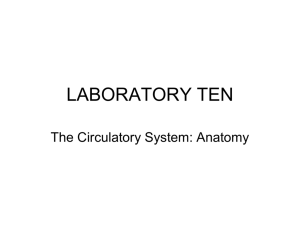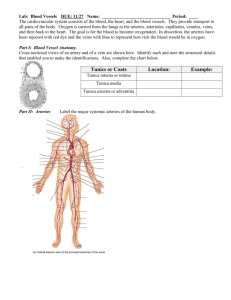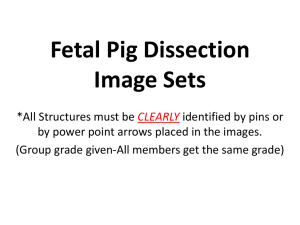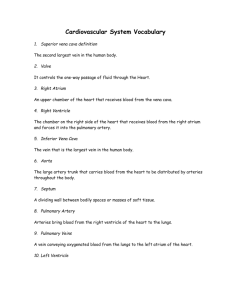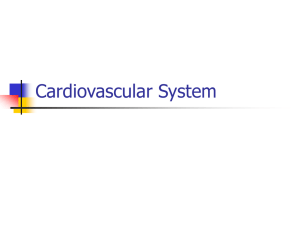Science Honors Human Anatomy and Physiology Unit 8: The Cardiovascular System
advertisement
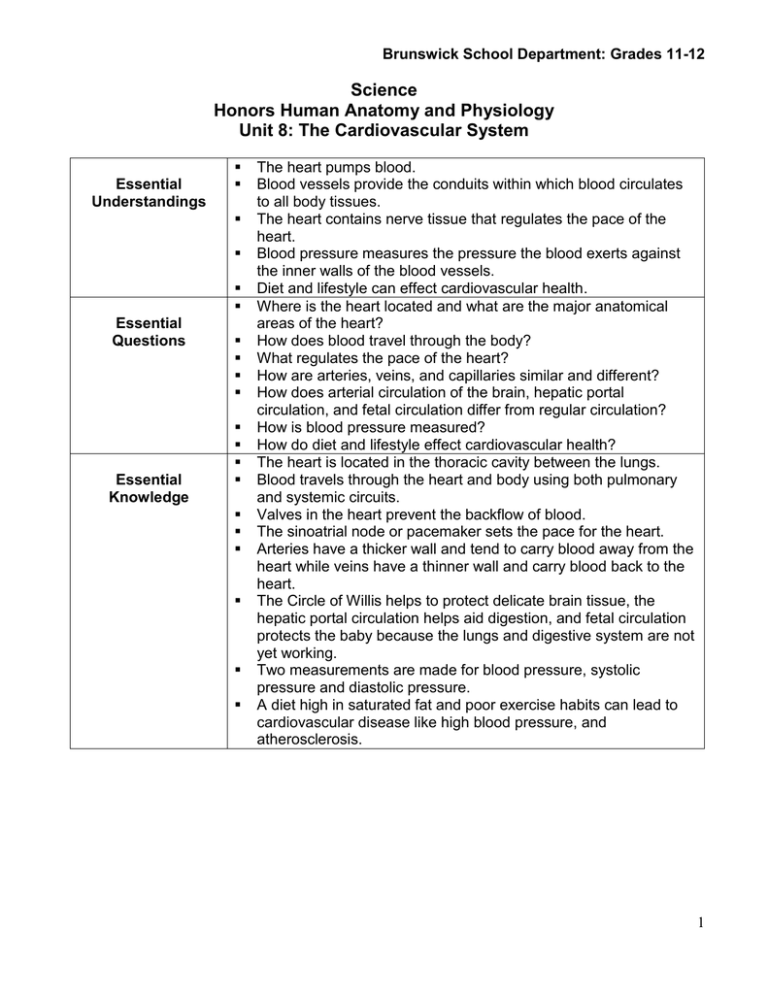
Brunswick School Department: Grades 11-12 Science Honors Human Anatomy and Physiology Unit 8: The Cardiovascular System Essential Understandings Essential Questions Essential Knowledge The heart pumps blood. Blood vessels provide the conduits within which blood circulates to all body tissues. The heart contains nerve tissue that regulates the pace of the heart. Blood pressure measures the pressure the blood exerts against the inner walls of the blood vessels. Diet and lifestyle can effect cardiovascular health. Where is the heart located and what are the major anatomical areas of the heart? How does blood travel through the body? What regulates the pace of the heart? How are arteries, veins, and capillaries similar and different? How does arterial circulation of the brain, hepatic portal circulation, and fetal circulation differ from regular circulation? How is blood pressure measured? How do diet and lifestyle effect cardiovascular health? The heart is located in the thoracic cavity between the lungs. Blood travels through the heart and body using both pulmonary and systemic circuits. Valves in the heart prevent the backflow of blood. The sinoatrial node or pacemaker sets the pace for the heart. Arteries have a thicker wall and tend to carry blood away from the heart while veins have a thinner wall and carry blood back to the heart. The Circle of Willis helps to protect delicate brain tissue, the hepatic portal circulation helps aid digestion, and fetal circulation protects the baby because the lungs and digestive system are not yet working. Two measurements are made for blood pressure, systolic pressure and diastolic pressure. A diet high in saturated fat and poor exercise habits can lead to cardiovascular disease like high blood pressure, and atherosclerosis. 1 Brunswick School Department: Grades 11-12 Science Honors Human Anatomy and Physiology Unit 8: The Cardiovascular System Vocabulary Mediastinum Apex Base Pericardium Fibrous pericardium Serous pericardium Parietal layer Visceral layer or epicardium Pericarditis Myocardium Endocardium Atria Ventricles Interventricular septum or interatrial septum Superior venae cavae Inferior venae cavae Pulmonary trunk Pulmonary arteries Pulmonary veins Pulmonary circulation Aorta Systemic circulation Atrioventricular or AV valves Bicuspid or mitral valve Tricuspid valve Chordae tendineae Semilunar valves Pulmonary valve Aortic valve Endocarditis Cardiac Circulation Coronary arteries Coronary sulcus or atrioventricular groove Anterior interventricular artery Circumflex artery Posterior interventricular artery Marginal artery Cardiac veins Coronary sinus Angina pectoris Infarct Myocardial infarction Intrinsic conduction system Nodal system 2 Brunswick School Department: Grades 11-12 Science Honors Human Anatomy and Physiology Unit 8: The Cardiovascular System Sinoatrial (SA) node Atrioventricular (AV) node Atrioventricular (AV) bundle (bundle of His) Bundle branches Purkinje fibers Pacemaker Heart block Ischemia Fibrillation Tachycardia Bradycardia Systole diastole Cardiac cycle Mid-to-late diastole Ventricular systole Early diastole Heart sounds “lub” “dub” murmurs Cardiac output (CO) Heart rate (HR) Stroke volume (SV) Regulation of Stroke Volume Starling’s law of the heart Venous return Muscular pump Congestive heart failure (CHF) Pulmonary edema Vascular system Arteries Arterioles Capillary beds Venules Veins Tunics Microcirculation Vascular shunt Terminal arteriole Postcapillary venule Precapillary sphincter Varicose veins Thrombophlebitis Pulmonary embolism 3 Brunswick School Department: Grades 11-12 Science Honors Human Anatomy and Physiology Unit 8: The Cardiovascular System Aorta Ascending aorta Aortic arch Thoracic aorta Abdominal aorta Right (R.) coronary arteries Left (L.) coronary arteries Brachiocephalic trunk R. common carotid artery R. subclavian artery L. common carotid artery Brachial artery Radial artery Ulnar artery Intercostals arteries Bronchial arteries Esophageal arteries Phrenic arteries Celiac trunk L. gastric artery Splenic artery Common hepatic artery Superior mesenteric artery Renal arteries Gonadal arteries Ovarian arteries Testicular arteries Inferior mesenteric artery Femoral artery Popliteal artery Anterior tibial artery Posterior tibial artery Dorsalis pedis artery Superior vena cava Inferior vena cava Radial veins Ulnar veins Brachial vein Axillary vein Cephalic vein Subclavian vein External jugular vein Vertebral vein Internal jugular vein 4 Brunswick School Department: Grades 11-12 Science Honors Human Anatomy and Physiology Unit 8: The Cardiovascular System Essential Skills Related Maine Learning Brachiocephalic veins Anterior tibial vein Posterior tibial vein Fibular vein Popliteal vein Femoral vein External iliac vein Great saphenous veins Common iliac (R. and L.) vein R. gonadal vein L. gonadal vein Renal veins Hepatic portal vein Hepatic (R. and L.) veins Cerebral arterial circle or circle of Willis Umbilical vein Umbilical arteries Ductus venosus Foramen ovale Ductus arteriosus Ligamentum arteriosum Hepatic portal circulation Pulse Pressure points Blood pressure Systolic pressure Diastolic pressure Hypotension Orthostatic hypotension Circulatory shock Hypertension or high blood pressure Congenital heart defects Coronary artery disease Atherosclerosis Arteriosclerosis Recognize and identify different regions of the heart. Be able to describe the pathway blood takes through the heart and body. Be able to compare and contrast arteries, veins, and capillaries. Be able to interpret a blood pressure reading. Recognize the effect of lifestyle on the cardiovascular system. Science A. Unifying Themes A1.Systems 5 Brunswick School Department: Grades 11-12 Science Honors Human Anatomy and Physiology Unit 8: The Cardiovascular System Results Students apply an understanding of systems to explain and analyze man-made and natural phenomena. a. Analyze a system using the principles of boundaries, subsystems, inputs, outputs, feedback, or the system’s relation to other systems and design solutions to a system problem. b. Explain and provide examples that illustrate how it may not always be possible to predict the impact of changing some part of a man-made or natural system. A3.Constancy and Change Students identify and analyze examples of constancy and change that result from varying types and rates of change in physical, biological, and technological systems with and without counterbalances. B. The Skills and Traits of Scientific Inquiry and Technological Design B1.Skills and Traits of Scientific Inquiry Students methodically plan, conduct, analyze data from, and communicate results of in-depth scientific investigations, including experiments guided by a testable hypothesis. a. Identify questions, concepts, and testable hypotheses that guide scientific investigations. b. Design and safely conduct methodical scientific investigations, including experiments with controls. c. Use statistics to summarize, describe, analyze, and interpret results. d. Formulate and revise scientific investigations and models using logic and evidence. e. Use a variety of tools and technologies to improve investigations and communications. f. Recognize and analyze alternative explanations and models using scientific criteria. g. Communicate and defend scientific ideas. B2.Skills and Traits of Technological Design Students use a systematic process, tools and techniques, and a variety of materials to design and produce a solution or product that meets new needs or improves existing designs. a. Identify new problems or a current design in need of improvement. b. Generate alternative design solutions. c. Select the design that best meets established criteria. d. Use models and simulations as prototypes in the design planning process. e. Implement the proposed design solution. 6 Brunswick School Department: Grades 11-12 Science Honors Human Anatomy and Physiology Unit 8: The Cardiovascular System f. Evaluate the solution to a design problem and the consequences of that solution. g. Present the problem, design process, and solution to a design problem including models, diagrams, and demonstrations. C. The Scientific and Technological Enterprise C1.Understandings of Inquiry Students describe key aspects of scientific investigations: that they are guided by scientific principles and knowledge, that they are performed to test ideas, and that they are communicated and defended publicly. a. Describe how hypotheses and past and present knowledge guide and influence scientific investigations. b. Describe how scientists defend their evidence and explanations using logical argument and verifiable results. C2.Understanings About Science and Technology Students explain how the relationship between scientific inquiry and technological design influences the advancement of ideas, products, and systems. a. Provide an example that shows how science advances with the introduction of new technologies and how solving technological problems often impacts new scientific knowledge. b. Provide examples of how creativity, imagination, and a good knowledge base are required to advance scientific ideas and technological design. C3.Science, Technology, and Society Students describe the role of science and technology in creating and solving contemporary issues and challenges. b. Explain how ethical, societal, political, economic, and cultural factors influence personal health, safety, and the quality of the environment. c. Explain how ethical, societal, political, economic, religious, and cultural factors influence the development and use of science and technology. C4.History and Nature of Science Students describe the human dimensions and traditions of science, the nature of scientific knowledge, and historical episodes in science that impacted science and society. a. Describe the ethical traditions in science including peer review, truthful reporting, and making results public. b. Select and describe one of the major episodes in the history of science including how the scientific knowledge 7 Brunswick School Department: Grades 11-12 Science Honors Human Anatomy and Physiology Unit 8: The Cardiovascular System changed over time and any important effects on science and society. c. Give examples that show how societal, cultural, and personal beliefs and ways of viewing the world can bias scientists. d. Provide examples of criteria that distinguish scientific explanations from pseudoscientific ones. D. The Physical Setting D2.Earth Students describe and analyze the biological, physical, energy, and human influences that shape and alter Earth Systems. c. Describe and analyze the effects of biological and geophysical influences on the origin and changing nature of Earth Systems. d. Describe and analyze the effects of human influences on Earth Systems. D3.Matter and Energy Students describe the structure, behavior, and interactions of matter at the atomic level and the relationship between matter and energy. h. Describe radioactive decay and half-life. E. The Living Environment E1.Biodiversity Students describe and analyze the evidence for relatedness among and within diverse populations of organisms and the importance of biodiversity. a. Explain how the variation in structure and behavior of a population of organisms may influence the likelihood that some members of the species will have adaptations that allow them to survive in a changing environment. b. Describe the role of DNA sequences in determining the degree of kinship among organisms and the identification of species. c. Analyze the relatedness among organisms using structural and molecular evidence. d. Analyze the effects of changes in biodiversity and predict possible consequences. E2.Ecosystems Students describe and analyze the interactions, cycles, and factors that affect short-term and long-term ecosystem stability and change. 8 Brunswick School Department: Grades 11-12 Science Honors Human Anatomy and Physiology Unit 8: The Cardiovascular System a. Explain why ecosystems can be reasonably stable over hundreds or thousands of years, even though populations may fluctuate. b. Describe dynamic equilibrium in ecosystems and factors that can, in the long run, lead to change in the normal pattern of cyclic fluctuations and apply that knowledge to actual situations. E3.Cells Students describe structure and function of cells at the intracellular and molecular level including differentiation to form systems, interactions between cells and their environment, and the impact of cellular processes and changes on individuals. a. Describe the similarities and differences in the basic functions of cell membranes and of the specialized parts within cells that allow them to transport materials, capture and release energy, build proteins, dispose of waste, communicate, and move. b. Describe the relationship among DNA, protein molecules, and amino acids in carrying out the work of cells and how this is similar among all organisms. c. Describe the interactions that lead to cell growth and division (mitosis) and allow new cells to carry the same information as the original cell (meiosis). d. Describe ways in which cells can malfunction and put an organism at risk. e. Describe the role of regulation and the processes that maintain an internal environment amidst changes in the external environment. f. Describe the process of metabolism that allows a few key biomolecules to provide cells with necessary materials to perform their functions. g. Describe how cells differentiate to form specialized systems for carrying out life functions. E4.Heredity and Reproduction Students examine the role of DNA in transferring traits from generation to generation, in differentiating cells, and in evolving new species. c. Explain how the instructions in DNA that lead to cell differentiation result in varied cell functions in the organism and DNA. 9 Brunswick School Department: Grades 11-12 Science Honors Human Anatomy and Physiology Unit 8: The Cardiovascular System Sample Lessons and Activities Sample Classroom Assessment Methods Sample Resources d. Describe the possible causes and effects of gene mutations. E5.Evolution Students describe the interactions between and among species, populations, and environments that lead to natural selection and evolution. a. Describe the premise of biological evolution, citing evidence from the fossil record and evidence based on the observation of similarities within the diversity of existing organisms. b. Describe the origins of life and how the concept of natural selection provides a mechanism for evolution that can be advantageous or disadvantageous to the next generation. c. Explain why some organisms may have characteristics that have no apparent survival or reproduction advantage. d. Relate structural and behavioral adaptations of an organism to its survival in the environment. Locate and name structures on human heart models Do a sheep heart dissection Observe blood vessel microscope slides Learn to take blood pressure using a sphygmomanometer View cardiovascular system during rat and fetal pig dissections. Read articles related to disorders caused by homeostatic imbalance of the cardiovascular system Quiz Chapter Test Worksheets Labs Publications: o Essentials of Human Anatomy and Physiology, 9th edition by Elaine N. Marieb o Anatomy and Physiology Coloring Workbook: A Complete Study Guide by Elaine N. Marieb o Essentials of Human Anatomy and Physiology Laboratory Manual by Elaine N. Marieb Videos: o National Geographic: Inside the Living Body o National Geographic: The Incredible Human Machine Other Resources Lab Supplies 10
